So let me begin with a story. This is the story of someone who was carrying $11,000 of cash in his suitcase, because, as he informed me, he was “used to carrying lots of cash with him.” You know what thieves are used to? Thieving.
Several people have asked me about money belts in the past, and I find them immensely useful for keeping items safe and secure. If you’ve ever lost a wallet on a trip to another country, you’ll know that it’s a huge hassle dealing with getting it all back, especially if you’re trying to make phone calls to cancel the cards, or reactivate the replacements, and they put you on hold repeatedly for 20 minutes at a time and you have to pay international calling rates for the privilege of doing so.
(And yes, that’s exactly what happened. I won’t call out the bank in question, because that would be rude. But it starts with Bank and ends with of America. The bastards.)
So anyway, what’s so great about money belts? Well, they fit underneath your clothing, so they’re lot harder for pickpockets to find, and thus more likely to keep your cash, credit cards, and passport safe from getting lost or stolen. If you’re going somewhere with a reputation for pickpockets, it’s a good idea to bring one along. Travel pants with safety pockets are a great option as well, but you can buy a money belt for as little as $10, which is a lot easier for most people.
One thing you don’t want to do is put everything in there, as you don’t want to lose everything all at once. What I generally suggest is for people to split things up into at least two places: A money belt, with cash, a credit card, and a single ID (probably a passport), and a wallet, with cash, a credit card, and a second ID (probably a driver’s license). That way if you lose one or the other, it won’t be such a big deal handling the next few days of eating, sleeping, and dealing with it all. You can go further and split things up even more, but you should at least go this far (and also carry a photocopy of your passport somewhere totally separate, like in your bag).
So! With all the options out there, which one is right for you? Here’s what I think about all the major designs, and how they compare:
Money belts 101
1) The waist pouch
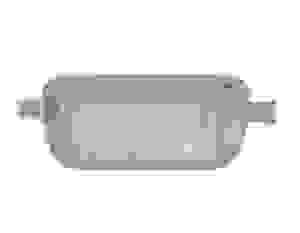
This is probably the most popular method, and the most versatile. It’s a simple pouch that hangs around your waist, and tucks into your pants. It’s nicely concealed, but still easily accessible; you can just reach in and pull it out, and tuck it back in when you’re done.
The larger size also helps with longer documents, like plane tickets, though some of the lengthier designs will get annoying for smaller people, as the edges will start digging into your legs. Check the dimensions first, but also remember that it’ll be mostly flexible; passports will probably be the only stiff thing in there.
Pros:
- Easily concealed
- Easily accessible
- Designs usually feature multiple compartments
- Long design can fit longer documents (like plane tickets)
Cons:
- Sometimes a little too long
- Not directly attached to anything, so if it’s unclipped, it’s no longer secure
- Make sure you get one with a good clip; some of of the flat-clip designs (the ones that look kind of like a seatbelt clip) can unclip themselves (the one pictured above does not have this problem)
- You need to get it out of the way to use the bathroom
2) The belt loop pouch
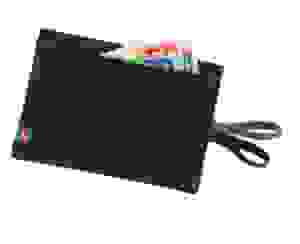
This one loops onto a belt, and then you tuck it into your pants. This is a bit more secure than the option above, since it can’t be easily removed, unless you remove the belt, or cut the cord.
Though not quite as simple to operate as the waist pouch (removing it and inserting it is a bit trickier), it’s still pretty simple, and smaller, too. The double-loop options allows you to use it with a black or brown belt, and it’ll blend in a little better. You can also use it without a real belt, by clipping a carabiner onto a pant belt loop, if necessary.
Pros:
- Better secured, by hanging directly from a belt
- Fairly easy to conceal and remove
- Generally made with multiple compartments
- Smaller than many other designs, but still big enough for a passport
Cons:
- Slightly trickier to operate than a waist pouch
- Detaching it altogether isn’t as quick, since it’s attached to a belt
3) The neck pouch
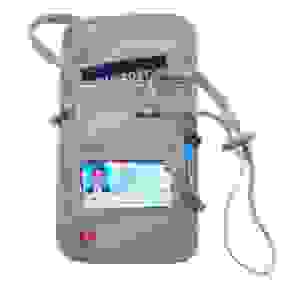
This one looks great in theory, but it’s a little trickier than you might think at first. You wear it around your neck, under a shirt. Accessing it therefore requires you to lift up your shirt, which can bring some unwanted attention. It also means that in hot environments, you’re wearing it right next to your skin, which can get icky. Plus the strap is usually visible, as it appears on the back of your neck, depending on what kind of shirt you’re wearing…so it’s not easily accessible, not always properly concealed, and potentially uncomfortable.
It’s not all bad, though. If you’re traveling somewhere relatively cold, and therefore will be wearing multiple layers, you can wear it in between those layers; over a t-shirt, but under a sweater, for example. This prevents it from feeling uncomfortable against the skin, and if the sweater has a high collar, it’ll block it from view. If it’s a full-zip sweater, you’ll be able to access it pretty easily through the zip. Another good method is to use this with a collared shirt and an undershirt, with the pouch stashed between those two layers. Again, the undershirt keeps you comfortable, the high collar blocks it from view, and you can undo a few buttons to get access to the pouch. In situations like those, this’ll be fine.
Pros:
- Multiple compartments
- Easily attachable and removable (if worn just around the neck)
Cons:
- Not so comfortable against the skin (so wear an undershirt, and put this on top)
- Not entirely secure if worn just around the neck (wearing it over just one shoulder is safer, but harder to remove)
- Strap can be visible up by the neck (wearing a collared shirt or a sweater with a high collar helps prevent this)
- Not easily accessible without lifting up a shirt (use with a buttoned shirt or a zip-up sweater to make it more accessible)
4) An actual belt
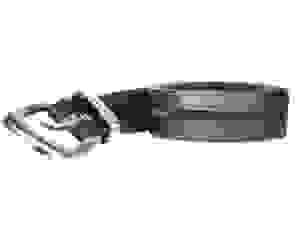
This one, as you might guess, is the most secure, but the least accessible, and with the least amount of storage.
As you can probably tell, you can’t fit much in there. You can get folded-up paper money in there, but no passport or credit cards. You can, however, fit copies of passports in there, folded up along with the cash. That’ll give you a spare document in case the original gets lost.
It’s not so easy accessing this while you’re out and about, so it’s probably a good place for storing backup cash that you don’t plan on spending immediately. You’ll probably still want another method for securing documents and credit cards, so I would generally recommend this one in addition to one of the other methods listed here, or along with travel pants with secured pockets.
Pros:
- Super-duper secure
Cons:
- Not much storage; usually best to use in conjunction with another money belt where you’ll store cards and passports
- Usually pretty weird looking…the above photo is one of the few leather belt versions available, which looks more normal. The rest are usually nylon webbing, so they look a little weird; check out Bison Designs for some nice-looking options, though.
- Someone should make that buckle out of carbon fiber so you can go through airport security metal detectors without removing it
5) The leg stash
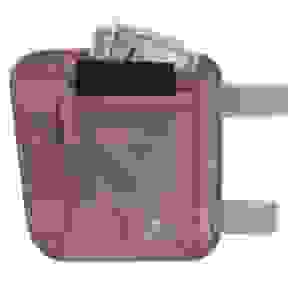
This one seems cool, but has some awkwardness problems.
Notice how it’s big enough to fit a passport? That’s great, except that passports are flat, and your legs are round. Your passport will get deformed if you store it in there.
That’s not necessarily bad, but until your passport gets deformed, it’ll be a little tricky sliding a flat passport into a curved chamber.
Grab your passport and squish it against your calf muscle. If it feels fine, then maybe this’ll work. It’s most likely to work better for people with larger legs, since your passport will fit more flatly against it, and you’ll be able to tighten the straps nicely (I was actually too skinny to get a tight fit with the one I tried). It’s also possible to wear this loosely around your ankle, which isn’t so bad, but might feel kinda weird. Plus, this is only for pants, not shorts, as it’s supposed to fit around the calf, not the thigh.
All in all, it’s not bad, but I expect it’ll feel better on certain body types, so try it out before you commit.
Pros:
- Easily concealable (with pants)
- Still fairly easily accessible
- Multiple compartments
Cons:
- Can’t be used with shorts
- Will probably fit better on certain body types (larger is probably better)
- Slimmer-fitting pants might feel awkward with it
6) A keyring wallet
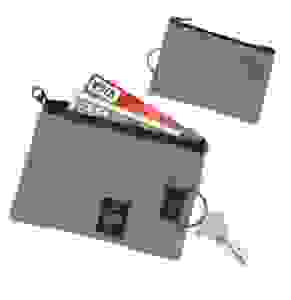
This is essentially a miniature version of the belt loop pouch listed above, and I’m pretty sure the people making it have no idea how useful this could be as a travel wallet, because all they think the keyring is for is for attaching keys. But if you loop the keyring onto a belt loop and tuck it into your pants, you get an easily-accessible wallet that’ll pop out whenever you need it, and tuck away when you’re done.
You can do this by feeding the keyring through the belt loop itself, or with an additional carabiner or short length of paracord or other really strong nylon string of some kind. There’s a double-zip version out there too, for even better organization.
I’ve seen some other designs that actually try to make a wallet like I’m describing, with a carabiner or a clip of some kind pre-installed, but I think adding some paracord to this keyring is actually more functional than some of the alternatives I’ve seen.
Pros:
- Easily accessible
- Easily concealable
- Can be securely attached to a belt loop, or a belt (the easiest way would be with some paracord)
Cons:
- Small; only good for cash and cards
- You’ll need your own carabiner or paracord loop, unless you use the keyring-directly-on-the-belt-loop method (which isn’t quite as simple to operate or detach)
7) The bra stash
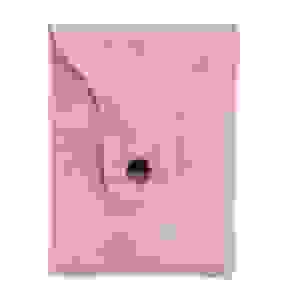
Ladies, this one’s for you. It’s tiny and discreet, and incredibly simple. You just clip it onto a bra strap (either centered or along the side), and that’s it.
These are usually quite small, just big enough for credit cards and folded-up cash, so passports will have to go somewhere else. I’ve seen some big enough for a passport, but I don’t think that’s going to be comfortable or well-hidden, so again, this is the type of thing that should be used in conjunction with something else. Still, it’s nice to be able to bring a secret wallet along for a night out without needing to bring a full-size money belt.
Beware, however, that there are stories out there of the snap coming undone by itself. While you’re wearing it, it probably won’t be a big deal, since it’ll be snugly pressed against you, but keep an eye on it when you’re changing clothes.
Pros:
- Tiny and discreet
- If anyone’s looking in there, you’ll probably know about it
Cons:
- Usually too small for a passport
- Not super-securely attached; it helps to be a little paranoid about the snap unsnapping itself
Summing up
Well, that just about covers the major options out there. Hopefully this’ll give you an idea of the pros and cons of each major design. I’ve used several of these, and it’s usually not until you’re a few days into a trip that you start running into the quirks of one particular design or another. I would still say the waist pouch is the most versatile design, and the most likely to work for most people, but the alternatives have plenty going for them as well.
One last thing, about RFID: Credit card scammers can use a machine that can read the magnetic strip on a credit card, just by walking right by. You won’t know they stole your credit card number until after they start buying things with it. This is definitely a concern, but I think that as credit card with microchips become more common, this strategy will become less and less useful, so I wouldn’t get too worked up about it. Several of the above options do have RFID blockers, though, so you’ll be safe from that particular problem.




I always wear the waist pocket. It never fails and can hold a little of everything. I recently bought the PortaPocket, but haven’t tried it out yet.
Another option is to make (sew) a flat pouch or pocket with zip or velcro closure and two button-holes at the top. Then on the inside of the waistband of your jeans or shorts you stitch two buttons. The pocket buttons on the inside of your waistband. It’s a DIY concealed pocket.
Yeah, I’ve seen instructional videos of those too. It’s a great idea, especially if you have trouble finding pants you like, and finally find something good, but there’s no hidden pocket somewhere.
I still have the ones my Mum made for me many years ago :-)
There’s one (newer) problem with the (US) passport-sized belts or carriers: the new US passports are VERY stiff, and don’t roll/curl like the old ones. The difference is similar to the difference between a spiral-bound notebook and a hardback book. As a result, the best and most comfortable place to stash your passport is the flattest body plane, and for many that is not going to be the place for which these belts are designed.
Yeah, I just got a new one, and it’s pretty stiff. Sooner or later it’ll get broken in, but it’s going to be annoying for a while.
Eytan, I would caution you on bending your new passport. The difference is the new passports have an embedded chip similar to new credit cards and I have been told that bending them can actually damage it.
Dangit. Well, we’ll see how long that lasts.
Look into cyclist jerseys with 2 to 3 pockets in the back as a under shirt to put the new US passport. Other pocket(s) on the jersey can hold back up credit cards, ID, emergency cash and a Passport Card if you have to leave your passport at the hotel front desk. Printing shouldn’t be a concern with the flat items when a backpack is on or wearing baggy clothing like a hoodie or rain jacket.
What am I missing? I may be blind, but it appears to me that you almost have to get undressed to access these money belts. It also strikes me that they would be very uncomfortable worn under clothing. The neck style appears to be the most comfortable and easiest to access. A simple set of illustrations/photos of how they are to be worn and accessed would be helpful. In the meanwhile, I just spread the wealth among my pants and shirt pockets and secured pockets in my travel vest.
The ones that tuck into the waistband are pretty easy. Imagine tucking and untucking a shirt.
You are missing the fact that these are not meant to replace your regular wallet. You should not be going into or out of your money belt at any point in public. This is your back up emergency supply. You use this to refill your regular wallet when you are in the privacy of your room/bathroom/somewhere where nobody can see you. No one should even know that you have a money belt, or it defeats the whole purpose.
I tried the waist pouch, but it’s bigger than necessary for passport, and uncomfortable when hiking or sitting, especially in hot weather.
Now favour a neck pouch, and have one just big enough for passport and cards. But, I wear it around the waist (not the neck), and tuck it in at the hip. This way, you don’t need a belt to hold it, and it is out of the way when hiking/sitting. Also keep some cash in pockets for easy access, and to placate muggers.
Thanks to SN for all the useful info.
Happy to help. I think a smaller waist pouch would be good…REI has one, but it has a belt clip that reviewers say comes undone a little too easily, so it just falls off…putting the belt pouch on an elastic band would work pretty well, though.
This is the one I’ve found useful.
The strap and cord-lock work fine as a ‘belt’ for it.
http://go-travelproducts.com/us/security/passport-holders/passport-pouch
I used a Pacsafe Coversafe 125 Anti-Theft Secret Belt Wallet (a belt loop wallet) in Europe for 2 weeks this past summer. It was designed a bit different than the one Eytan shows above in that it is tapered at the bottom (for comfort) and has an extended loop that makes it easier to retrieve and use, yet Velcros back to itself to keep it from dropping to far down in your pants. I found it to be very comfortable and easy to use. Looking at the Pacsafe website, it looks to be replaced with a new model that is much different and without some of these features. The model I got is still available on Amazon though.
Just a quick note on neck pouches; a friend that was traveling with us had her cord on her’s cord during an outing. Fortunately she noticed it before it was lost. If you are going this route, make sure it is in good order each time before using it.
When I wear a dress I like to use a garter purse around my thigh. I’ve gotten different versions on Amazon and Etsy. Although I think they are really meant for girls to go out clubbing they also work well for travel and the pocket is just big enough to hold a passport, cash, etc.
That’s a good option too. Better for skirts and dresses, whereas some of the options listed above work better for pants and shorts.
I have found the Roo Sport – http://theroosport.com/ – a great alternative to a belt it has an efficient magnet to secure the pocket to your pants rather than a belt.
While designed for athletes – of which I am not one – it is secure, comfortable, and easy to use. Despite its Australian sounding name it is made in the USA.
I just got the Chums Surfshorts wallet for Christmas. Used it as a travel wallet for flights to Disney World last week. Perfect in that sense, because I clipped it to the keychain fob in my north face day pack and had the extra layer of security with the zippers. Since it was a domestic flight, I didn’t need passport, but I used my TWIC card as ID so I never had to fumble with wallet at all, just kept it clipped and zipped.
It is actually kind of awkward to use with a key tucked in, much better the way you describe. Good article, I needed this info for an international trip coming up!
Security is important, but so is access. And I find any pouch which sits against the front of my abdomen to be uncomfortable when I am sitting down. It digs into me and I am constantly having to adjust it, which doesn’t look too good in front of others. So I divide my ‘valuables’ into two categories. The first category, what I will probably need today, such as foreign cash, a foreign-exchange debit card for ATMs and hotels, my passport, and my smartphone, are spread around different pockets (see below). The second category, stuff for emergencies, which might include a stash of dollars and/or euros, a spare foreign-exchange debit card, a normal credit card, driving licence, photocopy of passport, and list of useful phone numbers and addresses, goes in a neck pouch which hangs over one shoulder and rests on the opposite hip between my trousers and my underpants and which is kept in place by my belt. At a pinch, I can get the pouch out, but I try to do it in private.
Most of my clothes come from Rohan, whose sales line is ‘Technology disguised as clothing’. They are designed for travel but look everyday normal. A small wallet with the debit card and most of the banknotes goes into a zipped pocket hidden inside a trouser side pocket; coins and small notes are kept in a hip pocket with a concealed zip; the passport goes into a hidden pocket inside my shirt (I need to open a button to get at it); and the smartphone goes in the ‘touch and close’ breast pocket. I normally wear a lightweight zip-up jacket on top which provides additional security. The jacket also has zipped pockets which are useful for holding my phone, coins, and other metal things when going through security. It avoids having to lay them out on the trays provided.
I definitely prefer security pockets, which is why I look for pants with hidden zippers (I’ve listed a few over here), but they can be a pretty big investment, so I think money belts are good for people who only have $10 to spend.
I bought a set of 10 pockets with zippers and had them sewn on the inside of my BluffWorks Chinos, right behind the front pockets. I adjusted their height too. One pocket on each side. I can easily fit my passport, important documents and stacks of cash. It’s invisible from the front even when loaded, and then I still have regular things in my front pockets as “decoys”. I can also sit down with my passport in there and it doesn’t bend or stick out.
I’ve had travel belts before but they always left me with a weird feeling overall.
Thanks for your review!